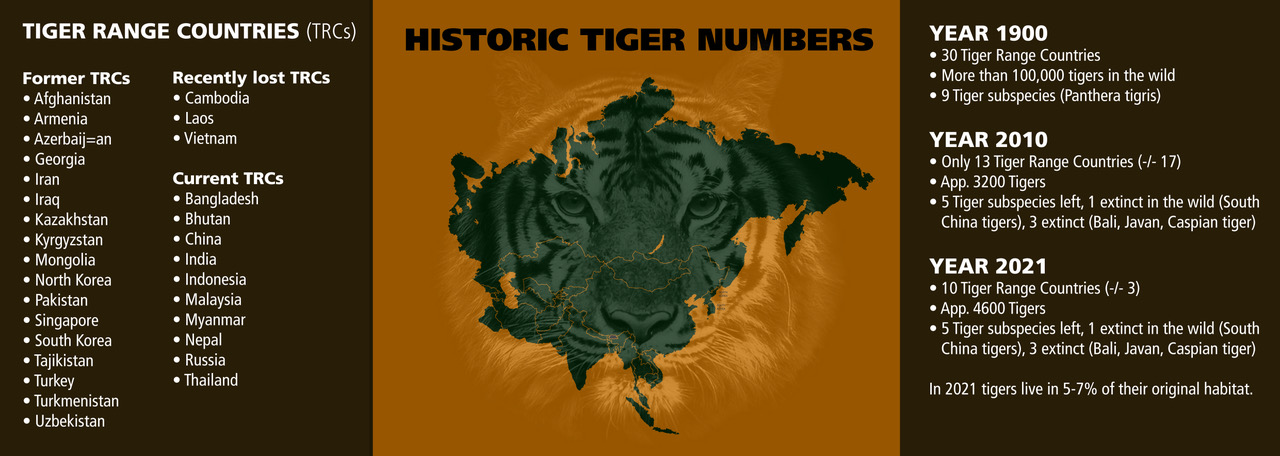What’s stopping some countries from keeping up with tiger conservation promises? (commentary)
Nov 9, 2021
- The last Global Tiger Initiative summit (GTI) was held in 2010, where tiger-range countries discussed the fall in tiger populations and future plans for tiger conservation.
- Since then, while India, Nepal, and Bhutan have made visible efforts to save their tigers, some other countries saw a decline in tiger numbers and acted with a lack of transparency and accountability.
- During the next tiger summit in 2022, all tiger-range countries need to take charge of conservation issues instead of hiding the truth to avoid humiliation. Conservation efforts must entail transparency, accountability, and the creation of a supervising authority.
- The views expressed are those of the author, not necessarily Mongabay.
Why are transparency and accountability important in tiger conservation?
Tiger conservation was already on the agendas of ecologists and biologists long before the U.N. introduced CITES in 1975. There were highs and lows in the last century, but the absolute low was in 2010 when the number of tigers in the wild dropped to around 3,200. The then-13 tiger-range countries and relevant organizations gathered in St. Petersburg, Russia, during the so-called Global Tiger Initiative summit (GTI). 2022 will see another tiger summit but, despite all good intentions, some countries will still act like saving tigers from extinction is not a serious matter.
This commentary will focus on two essential elements missing from international tiger conservation practice: transparency and accountability.
Losing face to prevent disgrace
The Panna Tiger Reserve is one of 53 Tiger Reserves in India and was declared as such in 1994. In 2007, it got an Award of Excellence from the Indian Ministry of Tourism for being the best-maintained park in India. Immediately after the news of the award got out, the buzz started. India sent a Special Investigation Team (SIT), and the report in 2009 showed that government, forest management, and staff had swept poaching incidents under the carpet. “Tourism got priority” was a major conclusion in the official report. It turned out that the people responsible had looked away when poachers struck. The result: Panna had lost all of its more than 40 tigers within six years.
In many parts of the world, losing face means a disgrace. The Panna example showed that people involved were just afraid to become a disgrace by admitting what was going on. Their fear led to devastating results for tigers.
For the rest in tiger conservation, it’s not any different. Conservationists, NGOs, and governments all have their secrets. They all cover up because they fear the consequences.
Historical overview of (counting) tigers
There have been many estimates about the number of tigers in the past. The most common one is that in 1900 the population of tigers in the wild was estimated to be around 100,000, distributed in 30 countries as we know them today. There were nine subspecies of tigers, three of which lived on the Indonesian islands of Bali, Java, and Sumatra.
Due to human impact (politics, growing population, growing wealth, greed, extensive poaching), tigers started losing their habitat quickly. In 2010, the number of tigers in the wild had dropped to around 3,200, with only 13 tiger-range countries left. At this all-time low, the World Bank, although not a regular player in tiger conservation, decided to act. That year, all tiger-range countries and tiger conservation parties came together to discuss the alarming situation.
The ‘Global Tiger Initiative’ (GTI) was the starting point for a global tiger recovery program: better conservation, better law enforcement, more awareness, and more funding. Parties also agreed on doubling the tiger numbers before the next Year of the Tiger (2022), officialized in the St. Petersburg Declaration on Tiger Conservation.
The number of tigers in the wild today is still unknown. But if all recent public numbers were combined with historical and never-updated figures, the number should be around 4,600. If all goes according to plan, all tiger-range countries will report their numbers before the next tiger summit, probably held in Vladivostok, Russia. But don’t be surprised if some countries won’t.

Evolution of counting
Methods of counting tigers have evolved in the last 30 years. Through the ‘pugmarks method,’ experts were able to identify which tiger belonged to which pugmark. However, regardless of the tremendous efforts, the reliability was low, so the method had to change.
Other methods were used, like counting scratch marks on trees and extrapolating data of registered areas based on educated guesses. But the biggest step forward was made when camera traps were introduced. Most tiger-range countries use them now to record tigers. But there is still room for improvement.
“Spending a lot of money and placing cameras without capture-recapture protocols is of no use. The longer you keep the cameras, the more will be the tiger count,” told noted tiger expert K. Ullas Karanth, the director of the Centre for Wildlife Studies, India, in 2020, quoted by The Federal, an Indian digital platform.
After continuous criticism, India — considered the leading tiger-range country — admitted there is no scope for “reconciliation of data,” “peer review, or inputs from other professionals” in the present scheme of things.
Responsible tiger countries
Since the GTI, several countries felt responsible and started to act on what was agreed upon. In the last 11 years, for example, India, Nepal, and Bhutan have shown their will to save tigers by using sophisticated systems to count and doing a census every four years to show the conservation progress. Counting and transparency also taught them how to improve their policies and activities.
For example, India had 1,706 tigers in 2010; four years later, 2,226; and 2,967 in 2018. India is now preparing the tiger census for 2022, which is expected to show around 3,700 tigers. The country committed to the summit goal in 2010, showing responsibility. Not all has gone or is going well, but they’re improving.
Saving tigers for India was more important than saving face, and it shows.
What about other tiger range countries?
Most tiger NGOs and international media still mention that the world has 13 tiger-range countries left, most likely not to offend the governments of the three countries that have lost all their remaining tigers in the last 11 years: Cambodia, Laos, and Vietnam.
Bangladesh dropped from more than 400 tigers to a few more than 100. Malaysia hasn’t published the 2019-2020 tiger census results yet, although they are already known. According to WWF, the preliminary results of this survey show that Malaysia has lost at least 60 percent of its 500 tigers since 2010.
China, Thailand, and Myanmar didn’t report in the last 11 years, despite their commitments to the GTI. The same goes for Indonesia, which once had three tiger species: the Balinese, Javan, and Sumatran. The Balinese and Javan tigers are already extinct due to excessive hunting, but we see different challenges nowadays. Palm oil and wood are key to the Indonesian economy. For decades, large parts of the island of Sumatra have been logged for wood and then burned down to grow palm trees to produce palm oil. NGOs continuously report this, afraid of losing Sumatran tigers, the entire ecosystem, and people falling sick because of the endless layer of smoke over the island.
Up until now, Indonesia has never conducted a tiger census. There is no official reason why the country is still not transparent about its tiger numbers, but the prospect of losing face again after losing the Balinese and Javan tigers seems to play a big role.

The biggest secret in tiger conservation exposed
How is it possible that, despite written declarations signed by presidents, ministers, and all relevant tiger organizations, the last 11 years in tiger conservation results are far behind what was agreed upon? It’s because there’s no accountability and no supervision.
Tiger-range countries are responsible for making tiger conservation efforts and holding themselves accountable for their methods and results. There’s no authority above them, so they can do whatever they want.
Unfortunately, most countries didn’t prioritize tigers, as they promised to in 2010. Reasons could be that palm oil production has been more important to Malaysia and Indonesia; or that the wildlife mafia from China has been more influential than expected in Myanmar, Cambodia, Laos, and Vietnam; or that the need to keep people out of the protected Sundarbans — the biggest mangrove forest in the world — has not been possible in Bangladesh.
Bangladesh, Cambodia, Indonesia, Laos, Malaysia, Myanmar, and even Thailand have failed in a certain way. Every party involved in tiger conservation knows this. But nobody has the authority to tell the failing countries to step up their activities, budgets, and results. In the meantime, the world keeps losing more and more tiger habitats.
A change is needed
During the next summit in 2022, all tiger-range countries will decide how to proceed with tiger conservation. New vows will be made, but without active changes, these vows will be as worthless as most of the ones made in 2010.
Changes must entail transparency, accountability, and the creation of a supervising authority. These reforms must lead to a system in which countries can learn and be challenged and also receive financial and economic penalties if they don’t meet the targets, ideally controlled by independent media and scientists.
Tiger conservation can’t end up like the Panna Tiger Reserve case. India got that message right. Now it’s time for the underperforming countries to understand that saving face is not an option. What happened to Cambodia, Laos and Vietnam in the last 11 years can’t happen in the remaining tiger-range countries. We have to protect our tigers. It’s time for transparency and accountability.
Banner image of tigers by Camilla Malvestiti.